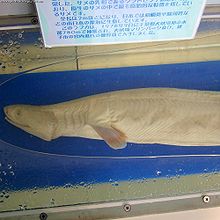Frilled shark: Difference between revisions
other captures |
GrahamBould (talk | contribs) m rv |
||
| Line 18: | Line 18: | ||
| binomial_authority = [[Garman]], [[1884]] |
| binomial_authority = [[Garman]], [[1884]] |
||
}} |
}} |
||
The '''frilled shark''', ''Chlamydoselachus anguineus'', is a primitive [[shark]] species, of the [[family (biology)|family]] '''Chlamydoselachidae''' in the [[order (biology)|order]] [[Hexanchiformes]]. The [[Southern African frilled shark]] is a proposed new species from the Southern African range. These two species are very |
The '''frilled shark''', ''Chlamydoselachus anguineus'', is a primitive [[shark]] species, of the [[family (biology)|family]] '''Chlamydoselachidae''' in the [[order (biology)|order]] [[Hexanchiformes]]. The [[Southern African frilled shark]] is a proposed new species from the Southern African range. These two species are very different from the other hexanchiform sharks, and it has recently been proposed that the two frilled sharks should be given their own order: '''Chlamydoselachiformes'''. Additional extinct types are known from [[fossil]] teeth; thought to be extinct itself, it was only discovered in [[Japan|Japanese]] waters in the [[19th century]].<ref name='allen48'>{{cite book|last=Allen|first=Thomas B.|title=The Shark Almanac|publisher=[[The Lyons Press]]|date=1999|location=New York|pages=48|isbn=1-55821-582-4}}</ref> On [[January 21]], [[2007]] a specimen was found alive off the coast of [[Japan]] near the Awashima Marine Park in [[Shizuoka]], southwest of [[Tokyo]]. The shark was captured but died shortly afterwards.<ref>[http://cbs5.com/watercooler/local_story_024183117.html CBS news story]. Accessed [[2007]]-[[01-25]]</ref> |
||
==Appearance== |
==Appearance== |
||
Revision as of 12:10, 14 February 2007
| Frilled shark | |
|---|---|

| |
| Scientific classification | |
| Kingdom: | |
| Phylum: | |
| Class: | |
| Subclass: | |
| Order: | |
| Family: | Chlamydoselachidae Garman, 1884
|
| Genus: | Chlamydoselachus
|
| Species: | C. anguineus
|
| Binomial name | |
| Chlamydoselachus anguineus | |
The frilled shark, Chlamydoselachus anguineus, is a primitive shark species, of the family Chlamydoselachidae in the order Hexanchiformes. The Southern African frilled shark is a proposed new species from the Southern African range. These two species are very different from the other hexanchiform sharks, and it has recently been proposed that the two frilled sharks should be given their own order: Chlamydoselachiformes. Additional extinct types are known from fossil teeth; thought to be extinct itself, it was only discovered in Japanese waters in the 19th century.[1] On January 21, 2007 a specimen was found alive off the coast of Japan near the Awashima Marine Park in Shizuoka, southwest of Tokyo. The shark was captured but died shortly afterwards.[2]
Appearance

Superficially the frilled shark resembles a dark brown or grey eel, but the six gill slits identify it as a shark. The tissue of the gill slits protrudes somewhat, thus inspiring the common name. Its dorsal fin is small, anal fin large, and the caudal fin (tail fin) is highly asymmetric, the dorsal part almost unnoticeable. Its teeth are small, tricuspid, and very sharp. It has been recorded at up to 2 m in length.
Distribution
Distribution is worldwide, but they are very rarely found in shallow water. The sharks are usually found at depths of between 50 m and 1,500 m. They typically eat squid, other sharks, and deepwater bony fish.[3]
Reproduction
Reproduction is not well understood, but like many other sharks they bear live young (ovoviviparous), with litter sizes of 2 to 12 pups. Compagno states "They are pregnant for a long time, probably one to two years".
Sightings

Frilled sharks appear regularly in the catches from bottom trawling, and when caught are used as food or for fishmeal.[3]
On January 21 2007, staff at Awashima Marine Park in Shizuoka, southwest of Tokyo, were alerted by fishermen to a 'strange eel-like fish with razor sharp teeth'. The fish was identified as a female 1.6 m frilled shark and was captured by park staff who were concerned that the shark appeared to be unhealthy. They took it out of the water and put it into a salt water tank where they filmed it and took pictures of it. The shark died a few hours after capture. This rare surface appearance of a frilled shark has been attributed to the animal being unwell and possibly disoriented.[4]
See also
References
- ^ Allen, Thomas B. (1999). The Shark Almanac. New York: The Lyons Press. p. 48. ISBN 1-55821-582-4.
- ^ CBS news story. Accessed 2007-01-25
- ^ a b Compagno (1984). Sharks of the World: An annotated and illustrated catalogue of shark species known to date. Food and Agriculture Organization of the United Nations. pp. 14–15.
- ^ "Rare shark captured on film". CNN. Retrieved 2007-01-24.
- Template:IUCN2006 Database entry includes justification for why this species is near threatened
- "Chlamydoselachus anguineus". Integrated Taxonomic Information System. 23 January.
{{cite web}}: Check date values in:|date=and|year=/|date=mismatch (help) - Compagno, Dando, & Fowler, Sharks, Collins Gem, HarperCollins, London 2006) ISBN 0-00-721986-5
- Compagno, Dando, & Fowler, Sharks of the World, Princeton University Press, New Jersey 2005 ISBN 0-691-12072-2
External links
- Prehistoric shark - frilled shark photographed
- Video of a frilled shark, filmed on Jan 21, 2007 (Japanese commentary)
- Video of a frilled shark, filmed on Jan 21, 2007 (English commentary by Reuters)
- Video of a frilled shark, filmed on Jan 21, 2007 Awashima marin park (Japanese)
- FishBase entry for Chlamydoselachus anguineus
- Rare shark of the deep snapped
- More info
- Sideview of living Chlamydoselachus anguineus
- Photograph of a live female frilled shark
- (Weird News) A rare eel-like creature identified as frilled shark is discovered in Japan by fisherman
- Rare shark captured on film (CNN, Jan 24, 2007)
